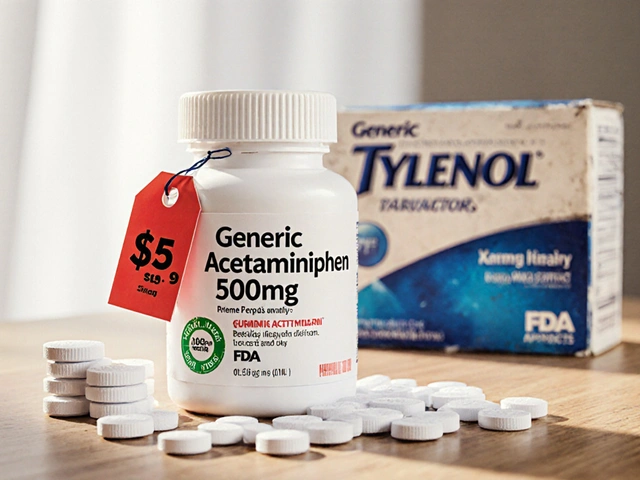Eye Inflammation Trigger Identifier
Answer the following questions to help identify possible triggers of your eye inflammation.
Symptoms
Lifestyle Factors
Environmental
Potential Triggers Identified:
Recommendation: Based on your selections, consider implementing lifestyle changes such as screen breaks, better sleep habits, or using a humidifier. If symptoms persist, consult an eye care professional.
When your eyes feel gritty, red, or swollen, it’s easy to reach for eye drops or a quick pharmacy fix. But a lot of eye inflammation can be softened with everyday habits you already have at home. Below you’ll find a no‑nonsense plan that blends simple lifestyle tweaks, kitchen‑cabinet cures, and smart nutrition so you can calm irritated eyes without a prescription.
TL;DR - Quick Wins
- Identify the trigger - allergies, screens, or lack of sleep.
- Start a 10‑minute cold compress routine twice a day.
- Use chamomile tea bags or cucumber slices as soothing pads.
- Boost omega‑3 intake with fish, flaxseed, or algae supplements.
- Keep eyelids clean with a diluted baby‑shampoo wipe.
What Exactly Is "Eye Inflammation"?
Eye Inflammation is a broad term covering redness, swelling, and irritation of the ocular surface or surrounding tissues. It can arise from infections like Conjunctivitis (inflammation of the thin membrane covering the white of the eye and inner eyelid), chronic conditions such as Blepharitis (inflammation of the eyelid margins often caused by bacteria or skin disorders), or simple irritants like dust and smoke. Knowing which form you’re dealing with helps you choose the right natural strategy.
Spot the Common Triggers
Before you dive into remedies, ask yourself these quick questions:
- Do you notice itching during pollen season? Allergic Conjunctivitis (an eye‑inflamed response to airborne allergens) could be the culprit.
- Have you been staring at screens for more than 6hours? Dry Eye Syndrome (insufficient tear production leading to irritation) often follows digital overload.
- Is there a habit of rubbing your eyes after a coffee or a night out? The friction can aggravate both Blepharitis and Ocular Rosacea (a vascular condition that inflames the eyelids and eyes).
Pinpointing the trigger narrows down which natural fixes will work best.
Everyday Lifestyle Tweaks
These habits are the backbone of any inflammation‑reduction plan.
- Screen hygiene: Apply the 20‑20‑20 rule (every 20minutes, look at something 20feet away for 20seconds) to give your tear film a break.
- Sleep: Aim for 7‑8hours; poor sleep spikes cortisol, which can worsen eye redness.
- Hydration: Drink at least 2liters of water daily; dehydration thins the tear layer.
- Air quality: Use a humidifier in dry rooms and keep windows closed during high pollen days.

Home‑Remedy Toolbox
Most of these items live in your kitchen or bathroom cupboard. Each one has a simple, repeatable protocol.
Cold vs. Warm Compress
| Aspect | Cold Compress | Warm Compress |
|---|---|---|
| Primary Goal | Reduce swelling, numb pain | Loosen clogged oil glands, improve circulation |
| Best For | Allergic reactions, acute redness | Blepharitis, styes, chronic dryness |
| How Long | 5‑10minutes, 2‑3 times a day | 5‑10minutes, once a day |
| Preparation | Wrap ice cubes in a clean cloth or chill a gel pack | Soak a clean washcloth in warm (not hot) water, wring out excess |
Start with a cold compress if the eye feels puffy or itchy. Switch to a warm compress a few hours later if you suspect blocked glands.
Chamomile Tea Bags
Chamomile contains flavonoids that calm inflammation. Steep two bags in hot water for 3minutes, let them cool, then place them over closed eyelids for 10minutes. Do this twice daily during flare‑ups.
Cucumber Slices
Cool cucumber slices act like a natural eye‑mask. Slice half a cucumber about ¼inch thick, chill for 15minutes, then lay them on each eye for 5‑7minutes. The high water content hydrates the skin around the eye while the coolness shrinks blood vessels.
Aloe Vera Gel
Pure aloe vera gel (no additives) has anti‑bacterial and anti‑inflammatory properties. Dab a tiny amount on the inner eyelid margin using a sterile cotton swab. Rinse gently after 5minutes. Repeat once a day-but avoid if you have a known latex allergy.
Nutrition & Supplements that Actually Help
What you eat feeds the inflammation cycle. Some nutrients are proven to soothe eye tissues.
- Omega‑3 Fatty Acids: Aim for 1gram daily from fish oil, krill oil, or algae capsules. Studies show omega‑3s improve the lipid layer of tears, reducing dryness and redness.
- Vitamin A: Supports the conjunctival epithelium. Include carrots, sweet potatoes, or a 5,000IU supplement if you’re low.
- Vitamin C & E: Antioxidants that protect ocular cells from oxidative stress. Citrus fruits and almonds are easy sources.
- Zinc: Essential for tear‑film stability. A handful of pumpkin seeds daily does the trick.
Pair these nutrients with a balanced diet rich in leafy greens, lean protein, and whole grains for best results.
When to Call a Professional
Natural methods cover most mild cases, but certain signs mean it’s time to see a doctor:
- Severe pain, sudden vision loss, or light sensitivity.
- Discharge that is thick, green, or yellow (possible bacterial infection).
- Symptoms persisting beyond 7days despite home care.
- Recurring styes or chalazia that don’t resolve.
An eye‑care professional can prescribe targeted drops or rule out conditions like uveitis that need medical intervention.
Quick Checklist - Daily Routine
- Morning: Warm compress (5min) → eyelid cleanse with diluted baby‑shampoo.
- Mid‑day: 20‑20‑20 screen break + sip water.
- Evening: Cold compress (5‑10min) → chamomile tea bag on eyes (10min).
- Night: Take omega‑3 supplement, ensure 8hours of sleep.
Stick to this pattern for a week and notice the reduction in redness and swelling.
Frequently Asked Questions
Can I use regular ice cubes for a cold compress?
Yes, but wrap them in a clean cloth to avoid direct skin contact, which can cause frostbite. A chilled gel pack works just as well.
Is it safe to put cucumber slices on my eyes if I have a latex allergy?
Cucumber itself is latex‑free, but make sure the knife and cutting board haven’t been used for latex‑containing foods. Rinse the slices well before placing them on your eyes.
How long should I wait before using a warm compress after a cold compress?
Give your skin at least 30minutes to return to normal temperature. This prevents a sudden temperature swing that could stress delicate eye tissue.
Do over‑the‑counter antihistamine eye drops interfere with natural remedies?
They generally complement natural methods. Just avoid using both a soothing tea‑bag mask and a medicated drop at the same minute; give the drop a minute to absorb first.
Can diet alone fix chronic dry eye?
Diet is a strong supportive factor, especially omega‑3s, but chronic dry eye often needs a combined approach: diet, environmental control, and possibly prescription eye drops.






Comments
Nathan Hamer
29/Sep/2025Wow, this guide is like a beacon of hope for tired eyes! 🌟 The way you break down the cold vs. warm compresses feels like a masterclass in ocular choreography. I can already picture the 20‑20‑20 rule dancing across my screen like a synchronized swimmer. The chamomile tea bag tip? Pure poetry! 🍵 And those cucumber slices? They're practically spa‑level luxury for the budget‑conscious. The emoji‑filled enthusiasm is intentional-because who said eye care can’t be fun? 😁 Let’s all grab a cucumber, a cold pack, and a dash of optimism and give our peepers the love they deserve! 👀✨
Stay bright, stay hydrated, and remember: every blink is a tiny celebration! 🎉
Tom Smith
29/Sep/2025Oh, because we all have a spare cucumber and a spa at home, right? Sure, just slap those tea bags on and hope for miracles while ignoring the underlying allergies. You’re basically telling us to DIY a pharmacy. 🙄
Kyah Chan
29/Sep/2025From a clinical perspective, the delineation between allergic conjunctivitis and digital eye strain is crucial. While the article enumerates lifestyle modifications, it omits a quantitative assessment of tear film osmolarity, which is a standard diagnostic metric. Moreover, the recommendation of a 10‑minute cold compress lacks citation of peer‑reviewed evidence supporting its efficacy in reducing vascular congestion. The inclusion of omega‑3 supplementation is evidence‑based; however, dosage parameters are not specified, potentially leading to subtherapeutic intake. In sum, the guide provides a useful overview but would benefit from incorporating validated clinical scales and referencing primary literature.
Ira Andani Agustianingrum
29/Sep/2025Hey, love that you’re taking charge of your eye health! A quick win for me is setting a timer on my phone for the 20‑20‑20 rule-once it buzzes, I stare out the window for a solid 20 seconds. It’s crazy how much that simple habit reduces the gritty feeling. Also, keep a bottle of sterile saline at your desk; a gentle rinse can wash away dust without the sting of drops. Remember to stay hydrated, too-water is the unsung hero for tear production. You’ve got this, and those cucumber slices will feel like a mini‑vacation for your lids.
James Higdon
29/Sep/2025While the natural remedies presented are largely benign, it is incumbent upon readers to recognize the limits of self‑treatment. Relying exclusively on home remedies for persistent or worsening inflammation may constitute negligence, especially when underlying pathology such as uveitis could be present. The ethical imperative is clear: seek professional evaluation if symptoms exceed seven days or if visual acuity diminishes. This approach upholds both personal responsibility and the medical community’s duty of care.
Wanda Smith
29/Sep/2025It is no coincidence that the wellness industry has flooded the market with cucumber slices and chamomile tea bags as miracle cures for eye inflammation. The manufacturers of these so‑called natural remedies have forged alliances with big‑pharma to divert attention from the real culprits-micro‑microbial agents embedded in our water supply. Every time you purchase a “organic” eye mask, you are unwittingly financing a covert operation that seeks to keep populations dependent on cheap substitutes rather than demand genuine medical research. They claim these remedies are harmless, yet they never disclose the traces of pesticide residue that linger on the vegetables, potentially aggravating ocular irritation. Meanwhile, the corporate lobbyists behind the scenes spin narratives about “holistic health” to undermine trust in evidence‑based ophthalmology. The recommendation to increase omega‑3 intake is particularly suspect, since the fish oil industry has a vested interest in promoting their supplements under the guise of natural therapy. Studies funded by these corporations frequently highlight marginal benefits while obscuring adverse effects such as bleeding risks. The article’s casual suggestion to use a humidifier ignores the fact that many devices harbor mold spores, which can exacerbate allergic conjunctivitis. In addition, the “screen break” advice fails to address the pervasive surveillance software that tracks eye movements and can manipulate visual ergonomics for profit. The omission of any warning about blue‑light filtering glasses is glaring, given that manufacturers of these filters receive subsidies from tech giants seeking to monopolize a new market segment. I suspect that the watering‑hole of “home remedies” is a strategic distraction, redirecting public attention away from systemic environmental pollutants that truly trigger inflammation. The emphasis on “DIY” solutions perpetuates a myth of self‑sufficiency that benefits only a handful of charismatic influencers, not the average sufferer. Therefore, before you plunge cucumber slices onto your eyelids, consider the broader agenda that profits from your discomfort. A critical, skeptical mindset is the most effective shield against the subtle manipulation embedded in seemingly innocuous health advice. Stay vigilant, and demand transparent sourcing for every ingredient you apply to your eyes.
Bridget Jonesberg
29/Sep/2025While I appreciate the elaborate exposition, one must recognize that the pathos employed here obscures the pragmatic merit of the suggested interventions. The disciplined application of a cold compress, for instance, remains a cornerstone of ocular therapy, irrespective of any alleged conspiratorial underpinnings. Moreover, the aesthetic articulation of such arguments often serves to elevate the discourse, albeit at the risk of alienating readers seeking straightforward guidance. In light of this, I propose a synthesis: adopt the proven modalities while maintaining a critical eye toward commercial narratives.
Marvin Powers
29/Sep/2025Alright, let’s break it down with some cultural flair-your eyes are the windows to the soul, but also the portal for screen‑induced fatigue. Imagine a Bollywood dance routine where every twirl is a 20‑20‑20 break; your eyes get a mini‑vacation, and you get a cardio boost. Swap the bland saline rinse for rose water-your grandparents swore by it for centuries, and it smells like a garden. And hey, if you’re skeptical about “organic cucumber,” just pop a frozen peas packet; same chill, less pretension. The point is, make these habits as fun as a TikTok trend, and you’ll stick to them longer than a fleeting fad.
Christopher Montenegro
29/Sep/2025From a pathophysiological standpoint, the adjunctive utilization of topical anti‑inflammatory agents supersedes the marginal efficacy of horticultural compresses. Empirical data indicates that lipid layer augmentation via omega‑3 fatty acids yields statistically significant improvements in tear film stability (p < 0.01). Conversely, the thermodynamic parameters of a cold compress are transient, effecting only vasoconstriction without addressing underlying immunologic cascades. Therefore, while the suggested home remedies possess anecdotal merit, they should be integrated within a comprehensive management algorithm that prioritizes pharmacologic intervention.
Kyle Olsen
29/Sep/2025Wow, such high‑falutin jargon for a simple eye itch-just use a cold spoon, buddy.